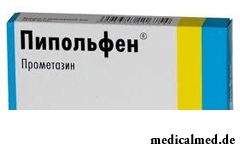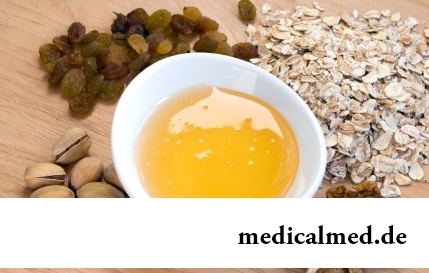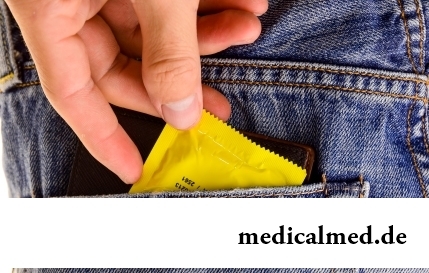





Pipolphenum
Application instruction:
 Pipolphenum – drug with antihistaminic, antiallergic, somnolent, sedative and antiemetic action.
Pipolphenum – drug with antihistaminic, antiallergic, somnolent, sedative and antiemetic action.
Form of release and structure
Dosage forms of release of Pipolphenum:
- Dragee (tablets, coated): light blue, with a brilliant surface, a lenticular form, almost without or inodorous (on 20 pieces in blisters, on 1 blister in a cardboard pack or on 25 blisters in a cardboard box);
- Solution for intravenous and intramuscular administration: with a green shade or colourless, transparent, almost without or inodorous (on 2 ml in colourless glass ampoules with a blue code ring and a point of a break, on 5 ampoules in blister strip packagings, on 2 packagings in a cardboard pack).
Is a part of 1 dragee:
- Active agent: a promethazine hydrochloride – 25 mg;
- Auxiliary components: potato starch, stearic acid, gelatin, magnesium stearate, talc, monohydrate of lactose;
- Cover: sucrose, ariavit blue, глицерол, talc, gelatin, a macrogoal 35 000, titanium dioxide.
Is a part of 1 ml of injection solution:
- Active agent: a promethazine hydrochloride – 25 mg;
- Auxiliary components: dipotassium sulfite – 0,75 mg, hydrochinone – 0,2 mg, sodium chloride – 7 mg, anhydrous sodium sulfite – 1 mg, water for injections – to 1 ml.
Indications to use
- Anaphylactic reactions (as additional therapy after stopping of acute manifestations by other drugs, for example, adrenaline);
- Allergic diseases, including a small tortoiseshell, a Quincke's disease, a serum disease, hay fever, allergic rhinitis and conjunctivitis, an itch;
- Before - and the postoperative period (as sedative);
- Kinetoz (for elimination and the prevention of nausea and dizziness during trips on transport);
- Postoperative pains (along with the anesthetizing medicines);
- Nausea and vomiting which is connected with an anesthesia and/or develops during the postoperative period (for stopping or the prevention of development).
Injection solution in surgical practice is also appointed as a component of lytic mixes which are applied to potentiation of an anesthesia.
Contraindications
Absolute:
- Comas or other types of deep oppression of the central nervous system;
- Apnoea syndrome in a dream;
- Drunkenness, acute intoxications opioid analgetics and/or somnolent drugs;
- Closed-angle glaucoma;
- Incidentally arising vomiting of not specified genesis at children;
- Simultaneous use with monoamine oxidase inhibitors, and also the period of 2 weeks after the end of their use;
- Pregnancy and period of a lactation;
- Children's age up to 2 months (injection solution) or 6 years (dragee);
- Hypersensitivity to promethazine, other derivatives of a fenotiazin, and also other components of drug.
Relative (Pipolphenum is appointed with care in the presence of the following diseases / states):
- Peptic ulcer with piloroduodenalny obstruction;
- Acute and chronic respiratory diseases (in view of suppression of a tussive reflex);
- Oppression of function of marrow;
- Open angle glaucoma;
- Diseases of cardiovascular system;
- Predisposition to an ischuria;
- Functional disturbances of kidneys and liver;
- Stenosis of a neck of a bladder and/or prostatauxe;
- Syndrome to Reja;
- Epilepsy;
- Advanced age (because of high risk of development of side reactions).
Route of administration and dosage
Pipolphenum is applied inside, intramusculary and intravenously.
The maximum adult daily dose makes 150 mg.
Intramusculary Pipolphenum is appointed the adult on 25 mg once a day, if necessary introduction each 4-6 hours of 12,5-25 mg of solution is possible.
The recommended dosing mode:
- Allergic diseases: inside on 25 mg 1 (evening) or 2 (in the morning and in the evening) once a day (it is recommended – in the smallest effective dose);
- Nausea and vomiting (treatment and prevention): once 25 mg inside or intramusculary. In case of need perhaps repeated use of Pipolphenum each 4-6 hours;
- Kinetoz: in 2 times a day on 25 mg (the first reception – in 30-60 minutes prior to a trip, following – in 8-12 hours);
- Surgeries (as calmative): once for night of 25-50 mg (inside or intramusculary) on the eve of carrying out operation. As a part of lytic mixes for preoperative preparation in 2,5 hours prior to carrying out operation intramusculary enter 50 mg of Pipolphenum, perhaps repeated introduction of the same dose in 60 minutes;
- Diagnostic and surgical interventions, including ophthalmologic operations, a repeated bronkhoskopiya (for induction of an anesthesia and an analgesia): intravenously on 0,15-0,3 mg/kg.
Children of 2 months can enter Pipolphenum 3-5 times a day intramusculary on 0,5-1 mg/kg. In hard cases increase in a single dose up to 1-2 mg/kg is possible.
To children of 6-14 years drug is appointed inside by 3-4 times a day on 25 mg. It is not recommended to divide a dragee therefore Pipolphenum in this dosage form is not appointed to children of younger age.
Side effects
- Alimentary system: a cholestasia, nausea, anesthesia of a mucous membrane of an oral cavity, a lock, vomiting, dryness in a mouth, a throat, a nose;
- Central nervous system: drowsiness, sedation, disorientation, visual acuity disturbance, dreadful dreams, increase of a night apnoea, uneasiness, psychomotor arousing, confusion of consciousness, dizziness; use of high doses – increase in convulsive activity (at children), extrapyramidal frustration;
- Hemopoietic system: seldom – an agranulocytosis, a leukopenia and/or thrombocytopenia;
- Cardiovascular system: bradycardia, lowering of arterial pressure, tachycardia;
- Sense bodys: accommodation paresis, ring or sonitus, vision disorder;
- Dermatological reactions: photosensitization and/or skin rash;
- Allergic reactions: bronchospasm, dermatitis, urticaria, photosensitization;
- Others: the painful or complicated urination, the increased sweating.
Special instructions
Pipolphenum can mask ototoksichesky action (in the form of a sonitus and dizziness) jointly the applied medicines.
At long therapy it is necessary to control systematically a functional condition of a liver and a formula of peripheral blood.
Pipolphenum can lower a threshold of convulsive readiness that should be considered at its appointment as the patient inclined to development of spasms, or together with other drugs with similar action.
As the antiemetic Pipolphenum needs to be applied only at long vomiting of the known etiology.
At a long course because of decrease in salivation the probability of development of dental diseases (a periodontal disease, caries, candidiasis) increases.
During therapy it is forbidden to take alcohol.
Obtaining false positive result when conducting diagnostic test on pregnancy is possible. It is also necessary to consider possible increase in level of glucose in blood at execution of the test on tolerance to glucose.
To prevent distortion of results of skin scarifying tests on allergens Pipolphenum should be cancelled in 72 hours prior to carrying out allergological tests.
At a lactose intolerance it is necessary to consider that lactose is a part of a dragee.
Children should appoint Pipolphenum with care as it can complicate diagnosis of a basic disease (syndrome symptoms to Reja and not diagnosed encephalopathy can be mistakenly taken for side effects of drug).
At the beginning of therapy it is necessary to abstain from control of motor transport and performance of other potentially dangerous types of works. Further extent of restriction is defined individually.
Medicinal interaction
At the combined use of Pipolphenum with some medicinal means / substances the following effects can be observed:
- Derivative m cholinomimetics, ephedrine, amphetamine, antikholinesterazny medicines, levodopa, guanetidin, dopamine: weakening of their action;
- Opioid analgetics, somnolent, anxiolytic (tranquilizers) and antipsychotic drugs (neuroleptics), and also medicines for the general anesthesia, local anesthetics, m-holinoblokatory and hypotensive medicines: strengthening of their effects (medical control and carrying out correction of doses is necessary);
- Beta adrenoblockers: increase in concentration of promethazine in a blood plasma;
- Barbiturates: acceleration of elimination and reduction of activity of promethazine;
- Prolactin: increase in its concentration;
- Bromocriptinum: weakening of its action;
- Clonidine, ethanol, antiepileptic drugs: strengthening of the oppressing influence of promethazine on the central nervous system;
- Anticholinergic medicines and tricyclic antidepressants: strengthening of m-holinoblokiruyushchey of activity of promethazine;
- Quinidine: increase in probability of cardiodepressive effect of promethazine;
- Monoamine oxidase inhibitors derivative of a fenotiazin: increase in probability of development of extrapyramidal frustration and arterial hypotension (co-administration with monoamine oxidase inhibitors is not recommended).
Terms and storage conditions
To store in protected from light, the place, unavailable to children, at a temperature of 15-25 °C.
Period of validity – 5 years.
Name of drug
Price
Drugstore
Scientists from the Oxford university conducted a number of researches during which they came to a conclusion that vegetarianism can be harmful to a human brain as leads to decrease in its weight. Therefore scientists recommend not to exclude completely from the diet fish and meat.

It is difficult to revaluate importance of kidneys for an organism. These bodies not only perform work on purification of blood of decomposition products and выв...
Section: Articles about health
Let's begin with the fact that a separate illness which is called "adjournment of salts", just does not exist. In practice this household name of disbolism leading to development of a number of diseases. Pathological process consists that in an organism проис...
Section: Articles about health
For many women the word "fat" sounds as a sentence. In aspiration to an ideal figure they try to exclude, first of all, from the menu all dishes containing fats without having at the same time a clear idea of a role of these substances in exchange processes, and of effects for health with which food restrictions of this sort are fraught. For what the human body needs fats and as their deficit in a diet is shown, we also will try to find out....
Section: Articles about health
At this plant there are a lot of names: tuberiferous sunflower, Jerusalem artichoke, solar root, earth pear. Contrary to spread...
Section: Articles about health
Proofs of efficiency of Mildronate at treatment of coronary heart disease with stenocardia can be found in many publications of the end of the twentieth century. Researches were conducted since 1984, including placebo - controlled effects. In total клиничес...
Section: Articles about health
Frosty air, fresh wind and easy snowball at most of Russians are associated with cheerfulness, health and cheerful entertainments on which our winter is so generous. But, unfortunately, cold season sometimes brings also troubles with health. It is not about seasonal colds and frostbites, and about those chronic illnesses which symptoms are shown preferential in the winter....
Section: Articles about health
Physical activity is necessary for normal functioning of a human body. At a lack of the movement cease функц...
Section: Articles about health
Not everyone can brag of the shining Hollywood smile. Even the person who is regularly visiting the stomatologist and watching of oral cavities over health periodically has problems: enamel of teeth darkens under the influence of some products, on it I accumulate...
Section: Articles about health
The next flu epidemic leads to the next panic, from year to year we give in on these manipulations: professionally alarming voice of the announcer in news, reports with calculation of the died patients, an interview with people in white dressing gowns and advertizing of anti-influenza means of different degree of inefficiency. All this reminds the Hollywood movies of epidemics threatening to destroy our planet. However, there is also one more similarity to cinema: everything comes to an end well. So, how to deal with the events, not in...
Section: Articles about health
Diseases of joints often begin imperceptibly for the person. The first stages of destruction of the cartilaginous tissue providing soft and свободн...
Section: Articles about health
The naturopathy sometimes moves as the new direction of medicine, something like fashionable hobby, and there is nothing farther from the truth. This most ancient direction, the word "naturopathy" is translated as "treatment by the nature", and, no doubt, treatment приро...
Section: Articles about health
Beauty shop – the place which is associated only with positive emotions: joy, pleasure, relaxation. However visit of salon where work with biological material of clients, not always harmlessly is conducted. Today more than 100 pathogenic microorganisms who can catch in beauty shop including deadly to health are known....
Section: Articles about health
Climax - process of fading of reproductive function of an organism in process of its aging. At women the main sign of its approach showing...
Section: Articles about health
On health of the person physicians know about salutary action of animals long ago. About 7 thousand years ago great Hippocrates recommended to the patients riding walks for strengthening of a nervous system and increase in vitality....
Section: Articles about health
Life does not indulge the modern woman special emotional comfort and carelessness. The fatigue, troubles at work, misunderstanding in a family and various illnesses immediately affect a condition of hair and skin. And there is a wish to look safe and attractive so! Substantially competently picked up diet can improve situation....
Section: Articles about health
Almost each of us during life faced dissatisfaction with own body. At such moments, as a rule, we beginning...
Section: Articles about health
People know that thermal sources have salutary force long ago. Treatment by natural waters is one of the most ancient methods of disposal of the most different diseases. Bathtubs, souls, wrappings and inhalations, in combination with reception of water vnut...
Section: Articles about health
Today about 30 diseases, sexually transmitted are known. Wide circulation of these illnesses is extremely promoted by the dual attitude towards them: on the one hand, most of people know about "shameful" diseases very little and do not aim at receiving detailed and reliable information, considering that such problems personally will never concern them. With another – there are delusions about STD which instill unreasonable confidence that troubles such...
Section: Articles about health
The thought that the mass of their body is too big at least once in life visits from 80 to 95% of women. Many...
Section: Articles about health
Very often as a source of the infection which caused a disease serves our house - the place which a priori has to be safe. However disease-producing bacteria can perfectly feel not only in insanitary conditions, but also in our apartment if not осущ...
Section: Articles about health
Bees – really unique beings. Practically all products of their life activity are used by the person. Since the most ancient times medicinal properties of honey and other substances received in the course of beekeeping are known. The fact that all these products are recognized not only national, but also official medicine is especially significant. About influence and routes of administration of bee "drugs" the speech in this article will also go....
Section: Articles about health
The modern person not always manages to find housing in the environmentally friendly region and such work which would not do harm здо...
Section: Articles about health
Wood louse – the ordinary-looking unpretentious plant extended in all territory of our country. It quickly expands, and sometimes fills sites, bringing a lot of chagrin to gardeners. Perhaps, they would be upset less if knew that the wood louse is the prices...
Section: Articles about health
(Xerostomia) many people consider feeling of a xerostomia small and easily removable inconvenience. This delusion: the symptom can demonstrate existence of serious diseases. It is worth to remember also that saliva performs important functions in an organism: clears the surface of teeth of a food plaque, growth of pathogenic microorganisms oppresses, normalizes acid-base balance, liquefies food and helps to split the carbohydrates which are contained in it. Chronic deficit слюн...
Section: Articles about health
The advantage of swimming for the person is so high that this sport is not only the most popular, but also is widely applied in copper...
Section: Slideshow
Is told about advantage of domestic animals for development of the child much. But many parents nevertheless do not hurry to bring pets as are afraid that they can do harm to health of children. What troubles can really trap kids and how to make with...
Section: Articles about health
It is known that the person for 80% consists of water which participates in all processes of an organism. The person loses liquid daily – as a result of sweating, breath, an urination, and its insufficient completion due to various reasons can lead to dehydration of varying severity. Dehydration (dehydration) occurs already in case of loss of liquid in number of 1% of body weight and can result both in easy thirst, and by the death. In time to notice signs обезвож...
Section: Articles about health

